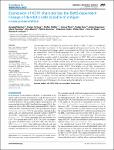Expression of XCR1 characterizes the Batf3-dependent lineage of dendritic cells capable of antigen cross-presentation
Bachem, Annabell
Hartung, Evelyn
Güttler, Steffen
Mora, Ahmed
Zhou, Xuefei
Hegemann, Anika
Plantinga, Maud
Mazzini, Elisa
Stoitzner, Patrizia
Gurka, Stephanie
Henn, Volker
Mages, Hans Werner
Kroczek, Richard
Cross-presentation of antigen by dendritic cells (DCs) to CD8+ T cells is a fundamentally important mechanism in the defense against pathogens and tumors. Due to the lack of an appropriate lineage marker, cross-presenting DCs in the mouse are provisionally classified as “Batf3-IRF-8-Id2-dependent DCs” or as “CD8+ DCs” in the spleen, and as “CD103+CD11b− DCs” in the periphery. We have now generated a mAb to XCR1, a chemokine receptor which is specifically expressed on CD8+ DCs and a subpopulation of double negative DCs in the spleen. Using this antibody, we have determined that only XCR1+CD8+ (around 80% of CD8+ DCs) and their probable precursors, XCR1+CD8− DCs, efficiently take up cellular material and excel in antigen cross-presentation. In lymph nodes (LNs) and peripheral tissues, XCR1+ DCs largely, but not fully, correspond to CD103+CD11b− DCs. Most importantly, we demonstrate that XCR1+ DCs in the spleen, LNs, and peripheral tissues are dependent on the growth factor Flt3 ligand and are selectively absent in Batf3-deficient animals. These results provide evidence that expression of XCR1 throughout the body defines the Batf3-dependent lineage of DCs with a special capacity to cross-present antigen. XCR1 thus emerges as the first surface marker characterizing a DC lineage in the mouse and potentially also in the human.
No license information

